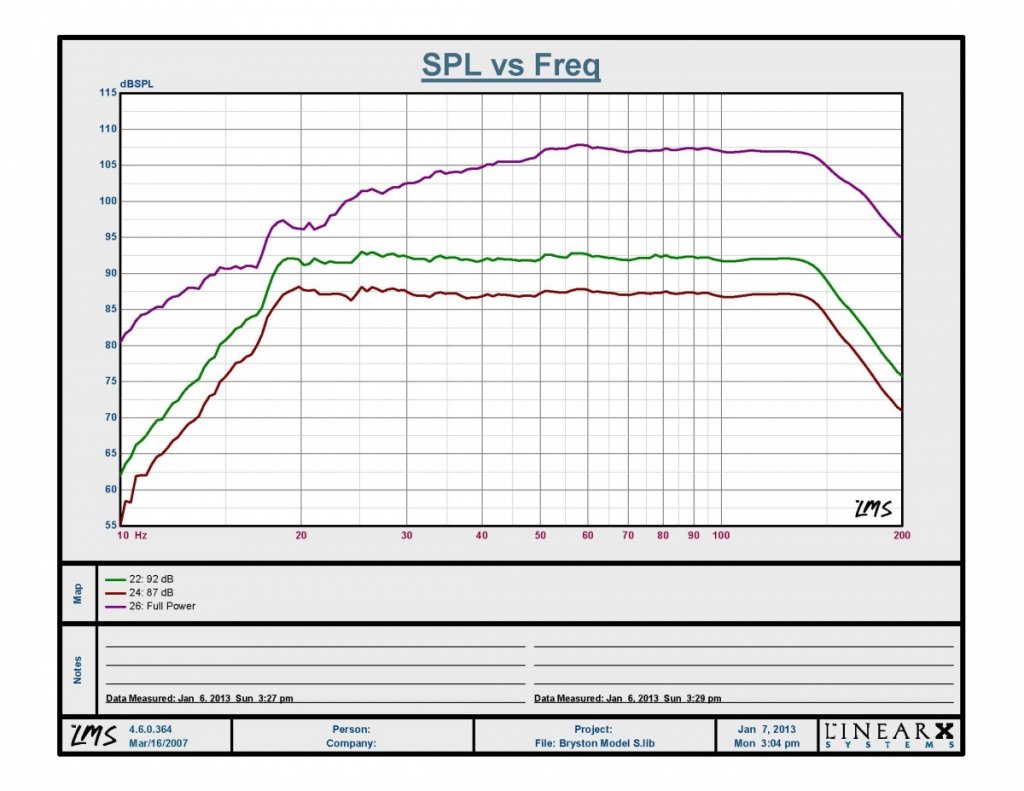MEMO: To All Bryston Customers
SUBJECT: Bryston Model T Subwoofer
Bryston Subwoofer PhilosophyAttached are some of the graphs of the Bryston Model T 600 watt powered Subwoofer. It has excellent output down to 17 Hz with a max output of 108 dB in a 4pi environment. This is a solid subwoofer.

Subwoofers in many respects are much simpler devices than broadband loudspeakers. All of the frequencies they are reproducing are omni-directional so there is no family of curves or listening window to consider.
Distortion: The most important part of subwoofer distortion is that it does not produce any obnoxious mechanical noises during playback. Since the amplifier and drivers are a combined in the same physical unit this can best be accomplished with sophisticated limiters. For the Bryston Model T Sub we are doing it with a DSP, the ultimate limiter in our opinion. In a perfect world you would have enough subwoofers in your room to never hit any of the limits that would cause obnoxious noises but in the real world you want a good limiter in there for those odd soundtracks that have something wonky going on every once and awhile.
As for things like harmonic distortion our human tolerance of this is very high at low frequencies. We have done extensive testing on this. So if your goal is "no audible distortion", and I think that is the proper goal, then you can comfortable push the subwoofer's output to very high levels. The number that gets bandied around most often for subwoofers is 10% harmonic distortion plus noise. Unfortunately this is too simplistic because it depends at what frequency and if it is harmonically related or not, and even which harmonic if it is.
Limits: When setting the limits, which we can do quite precisely with the DSP, we are allowing the 2nd harmonic in the lowest frequencies, below 30 Hz, to reach about 6 dB below the fundamental. As the frequencies rise this spread rises also. Of course this is all moot if you have enough subwoofers in your room to never get close to these limits.
Output: Every room and listening preference will mean a different level of sheer output is required. This can be accomplished by one massive powerful subwoofer or by multiple subwoofers around the room. Small room acoustics being what they are, multiple subwoofers have advantages beyond just the sheer output gained. So I would say you should always increase your sheer output requirements by increasing the number of subwoofers, not simply getting a bigger and bigger single subwoofer. Going strictly by the math every time you double the number of subwoofers in the room you will add 6 dB of output. So four subwoofers, which is a nice number for small room acoustics, would add 12 dB to the overall output. In reality most small rooms will have a bass hump centered around 25 Hz and as you add subwoofers you will gain minimal output around the hump but you will gain significant output, more than 6 dB with each doubling, where you need it the most for smooth in room bass response - in the dips and valleys.
In Room Linearity: It can be argued, and somewhat rightly so, that linearity does not matter if you are using EQ in your system to adjust dips and peaks in your room for the sub frequencies. This said, not everyone is using EQ and there are good reasons why not doing so. Using EQ is not a simple thing to get right. Bryston does not recommend using EQ in a Subwoofer and we certainly have the equipment to set it up and implement it properly. Using two or four subs around the room is going to do a much better job of smoothing out the bass response in the room (assuming your subwoofers are linear in a 4pi environment to start with). In our view this is the proper way to achieve great bass in your listening room.